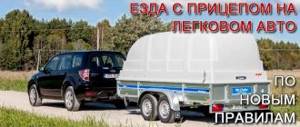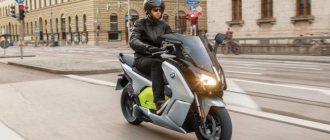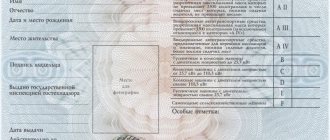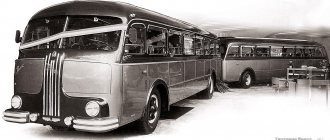To drive a car, you must have a driver's license with an open category corresponding to the type of vehicle. In some cases, it is sufficient for traveling by car with an attached trailer. However, there are a number of restrictions, in the presence of which it is necessary to open also subcategory “E”. Drivers with subcategory licenses “E to B”, “E to C” and “E to D” have all permissions to drive a car with any trailer, but what to do if they only have categories “B”, “C” or “D”?
When a trailer license is not needed
In paragraph 1 of Art. 25 of the Federal Law “On Road Safety” lists the criteria for admission to driving vehicles. The norm provides for cases in which it is permitted to connect with a trailer without a category “E” certificate. For drivers of passenger cars, the following situations are exceptions:
- if the total weight of the trailer does not exceed 750 kg;
- if the weight of the trailer is more than 750 kg, but less than the weight of the car without load, provided that the total composition is less than 3.5 tons.
The same article also considers cases in which a trailer is coupled to cargo and passenger vehicles. They do not require opening category “E” only when connecting a trailer with a gross weight of up to 750 kg.
How much does a light trailer weigh on average?
How to tow a car
A large number of manufacturers and brands of trailers sometimes make it difficult for even experienced drivers, not to mention beginners, to choose.
One of the most important tasks that every trailer buyer must decide for himself is determining its weight.
The fact is that this parameter directly affects many operational factors, and we’ll talk about how much a passenger trailer weighs and how to understand whether it’s worth buying.
How much does a passenger trailer weigh and how does it affect operation?
First, let's figure out exactly what number we need among all the characteristics of the trailer. Most often, manufacturers indicate 3 main parameters that relate to weight:
- load capacity - the maximum load that can be transported in a trailer;
- curb weight - the weight of an empty trailer with all equipment;
- gross weight is the permitted maximum, which is calculated using the formula “trailer curb weight + load capacity.”
Thus, to determine the weight of the trailer itself, the “curb weight” parameter is needed. However, if you choose only by it, you can easily make a common mistake among trailer buyers.
The fact is that trailers weighing more than 750 kg require an additional category “E” on your driver’s license. And these 750 kg are calculated according to the “total weight” parameter. Therefore, if you do not have category “E” and you are not eager to apply for it, please note that the weight of the trailer together with the cargo should not exceed 750 kg.
So, when choosing a trailer, first of all, decide what kind of cargo you plan to transport, find out their weight and, based on this figure, select the trailer. For example, you plan to transport potatoes in batches of 400 kg. We count: 750 - 400 = 350 kg. Thus, the curb weight of the trailer must be 350 kg or less with a load capacity of 400 kg.
Fortunately, modern trailers are very technologically advanced, so they have a low curb weight (on average from 200 kg) with a large load capacity, which will allow you to take the option “with a reserve”. Now you know how to determine how much a passenger trailer weighs and what this parameter affects, which means you are ready to choose it yourself or help a friend with advice.
LLC TD "SaranskSpetsTekhnika": trailers for any task
We always have a wide range of Russian-made trailers in stock for private and commercial purposes.
There are universal models, as well as options for specialized equipment (ATVs, PVC boats, snowmobiles).
Some trailers are equipped with useful options such as a stall mechanism, in addition, our products use modern patented solutions developed by our design office.
You can clarify all questions regarding the parameters of models from our catalog, delivery and payment issues by phone.
What is the permissible weight of a trailer and how to find it out
The permissible weight of a trailer, also known as gross or maximum weight, is the sum of its actual weight with the permissible load capacity. This value is indicated in the corresponding column of the PTS and the registration certificate. It is this that is the main guideline for determining the need to open category “E”, taking into account the weight of the car for the bunch.
There are 4 weight categories of trailers:
- O1 – 750 kg;
- O2 – from 750 to 3500 kg;
- O3 – from 3.5 t to 10 t;
- O4 – over 10 tons.
A trailer belonging to category O1 can in any case be used by a driver with a license of category “B”, “C” or “D”, regardless of the weight of the vehicle itself. Heavier O2 trailers almost always need to be driven by a driver with an "E" license, although there are exceptions for a "B" license. They allow you to drive a vehicle or road train if the vehicle itself is heavier than the trailer, and together they fit into the weight limit of 3.5 tons. For such an exception, category “B” is sufficient. Heavier O3 and O4 trailers require “CE”, “DE”, “C1E” and “D1E” licenses.
Power of attorney for trailer
According to the rules in force for 2021, the traffic rules provide for the need to transfer to other persons a completed document indicating all the relevant information.
Is a power of attorney necessary in practice? This is a philosophical question, since you never know whether the traffic police will stop you or not, will demand to show documents for a towed vehicle, or will they focus only on insurance and a driver’s license
Many people consciously take risks, simply hitching up someone else’s trailer and counting on fortune. I would not recommend doing this, because if you get caught by traffic police, fines and more serious problems cannot be avoided.
What kind of power of attorney is this? I often come across the concept of a general power of attorney. But officially such a concept does not exist in Russian legislation. It is used often, but mainly in relation to cars. In the case of caravans, the power of attorney is different.
Registration of an operating permit
If you are going to give your towed vehicle to someone for temporary use, then you should think about the correctness of the paperwork.
The operating permit can be of 2 types:
- handwritten, written in your own hand;
- printed on a special form.
Now choose for yourself what you want. Handwritten in its legal force is similar to a special form. It is not difficult to download the corresponding form. If you look at the sample, you will see that it is similar to the form that is used to issue a power of attorney for a car.
There is only one difference in the power of attorney for the right to operate a trailer. What do you think it is? Right. Instead of the name of the car, they indicate a device in the form of a trailer.
Let's move on to the issue of the design itself.
That is, we got to the most important and interesting. Print on your computer or fill out by hand
This is not fundamentally important.
- The first paragraphs of the form are used to indicate the details of the owner of the towed vehicle. This includes passport details, address and other personal information;
- The following columns serve to write similar information, but now about the person to whom you are going to transfer the right to operate the trailer;
- Then we write which trailer is the subject of the permit. Its state number, year of manufacture, registration data, insurance policy, etc. are indicated;
- Another important question is how long is this agreement valid? And you decide this yourself by indicating the relevant information in the document;
- The execution of the power of attorney is completed with the date of its completion and signatures.
Do I need to write anything else? Usually not. Just follow the samples and no questions will arise. Neither you nor the traffic police officers who stopped you with someone else’s towed vehicle.
Operating permits are filled out by hand using a similar principle. The main thing is that the power of attorney contains signatures, dates, and all information is indicated in accordance with the requirements of traffic regulations for the preparation of such documents.
Examples of calculations to determine the required category of rights
For a better understanding, consider a table with examples of calculations based on the weight of a trailer and a car.
| Machine weight, kg | Trailer weight, kg | Required category of rights | Explanation of calculations |
| 720 | 750 | B | The trailer belongs to category O1. |
| 1250 | 1050 | B | Although the trailer belongs to the O2 category, it is lighter than a car. Together they do not exceed 3.5 tons. |
| 950 | 1050 | BE | The car is lighter than an O2 category trailer. |
| 3100 | 850 | BE | Although the O2 trailer is lighter, together with the vehicle they exceed 3.5 tons. |
| 3100 | 740 | B | The trailer weighs less than 750 kg. |
| 1950 | 2100 | BE | The trailer is heavier, and together with the car they exceed 3.5 tons. |
| Machine weight (kg) | 720 |
| Trailer weight (kg) | 750 |
| Category of rights | B |
| Explanation of calculations | The trailer belongs to category O1. |
| Machine weight (kg) | 1250 |
| Trailer weight (kg) | 1050 |
| Category of rights | B |
| Explanation of calculations | Although the trailer belongs to the O2 category, it is lighter than a car. Together they do not exceed 3.5 tons. |
| Machine weight (kg) | 950 |
| Trailer weight (kg) | 1050 |
| Category of rights | BE |
| Explanation of calculations | The car is lighter than an O2 category trailer. |
| Machine weight (kg) | 3100 |
| Trailer weight (kg) | 850 |
| Category of rights | BE |
| Explanation of calculations | Although the O2 trailer is lighter, together with the vehicle they exceed 3.5 tons. |
| Machine weight (kg) | 3100 |
| Trailer weight (kg) | 740 |
| Category of rights | B |
| Explanation of calculations | The trailer weighs less than 750 kg. |
| Machine weight (kg) | 1950 |
| Trailer weight (kg) | 2100 |
| Category of rights | BE |
| Explanation of calculations | The trailer is heavier, and together with the car they exceed 3.5 tons. |
Carrying out calculations does not require complex mathematical calculations, so everyone can handle them. It is necessary to take into account that State Traffic Inspectorate employees check drivers of cars with a trailer to ensure that they have the necessary category of driving license. To do this, you will need to provide a driver’s license and a certificate of registration of the car and trailer at the request of the traffic police officer.
Briefly about the “E” in the certificate
Categories and subcategories of VU.
Until January 1, 2001, the letter “E” was placed on the driver’s license and it gave the right to drive all cars and a bus with a trailer. If the driver had open categories B, C and D, then he had the right to drive the designated vehicles with trailers attached to them.
After 01/01/2001, the following entries began to be made in the “special notes” column of the driver’s license: “E to B”, “E to C” and “E to D”. Moreover, they opened only those categories for which the exam was passed. Thus, a driver who had B, C and D on his license was given the entry “E to D” after passing the exam on an articulated bus, and to obtain other categories he had to pass separate exams.
Since March 2011, "E" is no longer included on driver's licenses. Now you need to open categories BE, CE and DE on your driver’s license. On November 5, 2013, legislators added two more subcategories C1E and D1E. Drivers with old licenses can exchange them for new ones. They will make all the entries that were in the previous document.
Responsibility for lack of rights of subcategory “E”
Illegal use of a vehicle in conjunction with a trailer in accordance with traffic regulations is punishable by law. It is the responsibility of every motorist using a trailer to ensure that he has the right to do so. If category “E” is required, then using a trailer in its absence is equivalent to driving without a license. According to Part 1 of Article 12.7 of the Administrative Code, such a violation entails liability in the form of a fine from 5 to 15 thousand rubles.
In addition to drawing up an administrative protocol, norm 27.12 of the Code of Administrative Offenses is applied to withhold a fine. She demands that the violation be stopped by removing the driver from the vehicle. The car itself with the trailer in accordance with Art. 27.13 Code of Administrative Offenses sent to the impound lot. Finding a car in a penalty area is accompanied by additional costs, which, depending on the region and duration of parking, can be equal to or exceed the amount of the fine itself. Thus, driving a car with a heavy trailer, the weight of which requires category “E”, is extremely undesirable.
Drivers may also be fined for overloading a trailer, so the lack of a suitable category of license may also result in it being weighed. When loading in excess of the permissible norm, Art. 12.21 of the Administrative Code, which provides for liability for violation of transportation and towing rules. It provides for a fine of 500 rubles.
Excerpt from traffic regulations on the operation of trailers for passenger cars
1.2. The Rules use the following basic concepts and terms: “Road train” is a power-driven vehicle coupled to a trailer(s). “Trailer” is a vehicle not equipped with an engine and intended to be driven in conjunction with a power-driven vehicle.
The term also applies to semi-trailers and trailers. “Vehicle” is a device designed to transport on roads people, goods or equipment installed on it.
“Motor driven vehicle” is a vehicle driven by an engine.
The term also applies to any tractors and self-propelled machines.
Documents for the trailer
2.1. The driver of a power-driven vehicle is obliged to: 2.1.1. Carry with you and, at the request of police officers, hand over to them for verification:
- a driver's license or temporary permit to drive a vehicle of the appropriate category;
- registration documents for this vehicle (except for mopeds), and if there is a trailer, also for the trailer (except for trailers for mopeds);
- insurance policy of compulsory civil liability insurance of the vehicle owner in cases where the obligation to insure one’s civil liability is established by federal law. (about cases when compulsory motor liability insurance is required for a trailer, read our article “Insurance for a trailer” - Buy a trailer)
Permitted speed with trailer
10.3. Movement outside populated areas is permitted:
for other buses, cars when towing a trailer, trucks with a permissible maximum weight of more than 3.5 tons on highways - no more than 90 km/h, on other roads - no more than 70 km/h;
Trailer lights and reflectors
19.1.
At night and in conditions of insufficient visibility, regardless of road lighting, as well as in tunnels, the following lighting devices must be turned on on a moving vehicle: on all motor vehicles and mopeds - high or low beam headlights, on bicycles - headlights or lanterns, on horse-drawn carts - lanterns (if available);
on trailers and towed motor vehicles - side lights.
Rules for transporting goods on a trailer
23. Transportation of goods
23.1. The weight of the transported cargo and the load distribution along the axles must not exceed the values established by the manufacturer for this vehicle.
23.2. Before starting and while driving, the driver is obliged to control the placement, fastening and condition of the load in order to avoid it falling and creating obstacles to movement.
23.3. Transportation of cargo is permitted provided that it:
- does not limit the driver's visibility;
- does not complicate control and does not affect the stability of the vehicle;
- does not cover external lighting devices and reflectors, registration and identification marks, and does not interfere with the perception of hand signals;
- does not create noise, does not create dust, does not pollute the road or the environment.
If the condition and placement of the cargo do not meet the specified requirements, the driver is obliged to take measures to eliminate violations of the listed transportation rules or stop further movement.
23.4.
A load protruding beyond the dimensions of the vehicle in front and behind by more than 1 m or on the side by more than 0.4 m from the outer edge of the side light must be marked with identification signs “Large load”, and in the dark and in conditions of insufficient visibility In addition, in front - a flashlight or a white reflector, at the back - a flashlight or a red reflector.
23.5.
Transportation of heavy and dangerous goods, movement of a vehicle whose overall dimensions, with or without cargo, exceed 2.55 m in width (2.6 m for refrigerators and isothermal bodies), 4 m in height from the surface of the roadway, and in length ( including one trailer) 20 m, or the movement of a vehicle with a load protruding beyond the rear point of the vehicle's overall dimensions by more than 2 m, as well as the movement of road trains with two or more trailers are carried out in accordance with special rules.
Fine: Article of the Code of Administrative Offenses 12.21. “Violation of cargo transportation rules, towing rules1. Violation of the rules for transporting goods, as well as the rules for towing, entails a warning or the imposition of an administrative fine in the amount of five hundred rubles.”
When is category “E” needed?
If the total weight of the trailer is more than 750 kg, you must be guided by the following rule: “If the total weight of the trailer does not exceed the curb weight of the car and the total gross weight of the vehicle does not exceed 3.5 tons, then an additional category is not required on the driver’s license.” . In all other cases, category “E” is needed.
At the same time, you need to be aware that only the information specified in the Vehicle Certificates of the trailer and car is of decisive importance. It is them that the inspector compares in a controversial situation. The fact that behind a car with a gross weight of 3.0 tons is a completely empty (not loaded) trailer with a curb weight of 350 kg. , despite the fact that the total weight of the trailer according to the documents is 1.3 tons will not be a mitigating circumstance. Law is law. And the inspector doesn’t care if the trailer is empty or loaded behind the car. Driving without an open corresponding category (in this case, category “E”) is equivalent to driving without a driver’s license, with all the ensuing consequences.
Small SUVs, such as NISSAN X-Trail, Suzuki Grand Vitara, etc., can be operated with a trailer with a gross weight of 1.3 tons. without category "E"
By the way, not every car can be driven with a trailer. If the manual or operating instructions for a car do not contain information about operating a car with a trailer, then it is better not to install a tow bar on such a car. You can read more here.
PS: At one time, without having the “BE” category, sometimes it was necessary to deliver trailers, the operation of which clearly required the “E” category. In order not to break the law, we loaded it onto a single-axle trailer with a total weight of 750 kg, of the appropriate size. Thus, the trailer, which required a category for independent travel, acted as cargo. In this form, we easily transported it to where we needed it. Sometimes it happened that on top, on a single-axle trailer without brakes, there was a two-axle trailer equipped with brakes. It would seem that on the contrary it would be much safer. However…
PPS: I eventually received the “BE” category. Now I can travel with any trailer completely unhindered...











